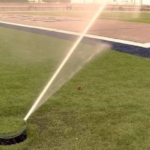With the deepening of winter, many areas have been covered with heavy snow. Snow is certainly a beautiful scene, but snow will have varying degrees of impact on people’s daily life and physical exercise.

As we all know, the raw materials of artificial turf are weather-resistant, and the cold and hot temperatures will not affect the service life of artificial turf. Under normal circumstances, the snow and ice covering the artificial turf will melt and evaporate or be discharged out of the field as the temperature warms up. With the intensification of the cold weather in the north, it becomes almost impossible for the ice and snow covering the lawn to melt and evaporate by itself, so these outdoor artificial lawns will inevitably be frozen into “ice grass” and become fragile and easily broken. The site should not be used before the ice and snow melt, otherwise, the grass will be damaged and the service life of the lawn will be affected.
At this time, the maintenance of artificial turf is particularly important. This article describes in detail how to maintain artificial turf covered by ice and snow.
1. Clearing machine/snowblower
If the snow is dry like powder, it can be removed from the playing field with a snow blower or a rotating brush, being careful not to sink the machine deep into the grass fibers when using it.
2. Remove with a rubber-scraping snow plow
Snow On sports fields, it is easier to remove wet or heavy snow with a snow plow.
3. Ice removal
If the artificial turf freezes, the ice on the field can be crushed with a heavy-duty roller, and the broken ice can be swept directly from the field. Usually when the sun is out, and when the ice or frost is not very thick, it will melt away quickly. The bottom fabric of artificial turf has drainage holes, and the snow will be drained from the drainage holes after melting. Finally, you only3. Ice removal needs to pay attention to the foundation. angle and treatment of the gutters.
If the ice is thick, chemicals can be used to cause it to melt. Spread about 100 Ibs of urea per 3,000 square feet (for reference only, it can be adjusted appropriately in different situations and different areas) After the urea is spread, it will take half an hour for the ice cubes on the field to melt. Melted ice should be cleaned with a washer, rubber cleaner, sweeper, or other suitable equipment. Urea has little effect at -12°C, and cannot melt ice at all at -17°C. A small amount of urea residue will remain on the site, which will be cleaned up, weather permitting.
Do not use salt, mineral salt, calcium chloride, or other corrosives and toxic chemicals to melt the ice on the surface of artificial grass, their residues will cause damage to athletes, equipment and turf.
The above are the common methods for removing ice and snow from artificial turf.



